Crazy Horses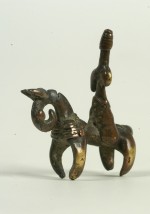
I’ve never been in Africa.
I don’t know how to ride a horse.
I’m not, I presume, possessed.
But I am the greatest expert and most passionate collector
of African Kotoko horsemen .. .. among those of the generation that
Leonardo defines as “… e beh !”, that is, when you hear that one of them has died,
you open your arms a bit saying; “So how old was he\she? … oh, well..!”.
This preamble clarifies the motives and limits of what I’m posting today, Wednesday 17 November 2010.
These miniature equestrian monuments thrill me
1
their microscopic monumentality. Tiny, just a few millimetres. But if you display them well, they rapidly and decisively conquer all the space around them.
You’re in front of them exactly like you’re in front of an equestrian monument in the middle of a square. The principle is the Japanese suiseki: a tiny evocative stone, sufficient capacity of concentration and imagination, and there it is: the gigantic mountain is alive and palpitating before you. It is the same with a Kotoko horseman: you are tiny, he is gigantic. Magic.
2
visual echoes, school memories, serene hours – Cangrande della Scala, Bonino da Campione, Verona and Venezia.
Gothic and Romantic echoes rather than Classic or Renaissance. Because Verrocchio’s Colleoni in Campo San Zanipolo and Donatello’s Gattamelata at the ‘Santo’,
not to mention Marco Aurelio in the Campidoglio, speak another more cultured language.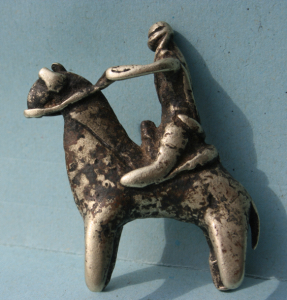
3
the discovery of non-existent but undeniable elective affinities: the little votive horses of the 9th-7th century Greece before Christ,
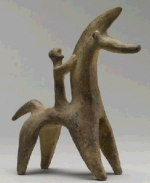
the chefferies south of the Sahara, from the appearance of the first Islamic horsemen up to today ?
And the Tang horsemen?
And this mysterious Iberian horseman, dated 6th century B.C. ?
And this other beautiful Iberian, dated 5th/6th B.C. ?
4
the therapeutic value: not a sculpture, but a medicine
to take every day, day and night, for months and perhaps for years.
Placebo effect or medicine of the future?
5
topsy-turvy iconography: the horse is not a horse but represents the human being possessed by a spirit;
the horseman is not a man and must not represent a man because he’s a possessing spirit.
6
irreverent thoughts : if in the sculptural group the horses represent the women or the men being possessed by the spirit,
then a well-endowed horse represents a possessed man but not a possessed woman ?
7
I believed that my love was unique and secret until a few hours ago I discovered an equally ardent love. I can only bow to a passion
expressed with so much intensity, with such an infinite deployment of means and, above all, which creates such an exciting and impelling result.
Useless to waste adjectives : I invite my readers to discover, visit, study and be enchanted by the fruit of a love surely as great as mine :
http://www.africarte.it/collezioni/PierLuigiPeroni1/collezione_peroni_kotoko.htm
Post Scriptum
Title of this posting: “Crazy Horses”.
Title of the book I’ve dreamed of writing for years : “Crazy Horses”.
Why?
Because when a title is beautiful it’s beautiful.
No need to explain it: it’s international, evocative and impelling: it’s centred and has that essential pinch of self-irony. One can’t do better.
Because these minute monumental sculptures really represent a crazy horse ridden by a spirit that possesses it.
Because all of us, adolescents in Paris, with the excuse of fine-tuning our French, dreamed about the Folies Bergères,
But we all ended up, lying about our age, at the entrance to the ‘Crazy Horse’.
Because today I find myself in love with objects representing a crazy horse.
A propos: all of us who are fans of Westerns know about the famous chief, Crazy Horse, but in the Lakota language, ’Crazy Horse’ is ’Tasunke Witko’.
By now it’s habitual, even in the United States, to call the Oglala war chief ’Tasunka Witko’.
But that’s wrong: the correct version is ‘Tasunke Witko’,
where the initial ‘Ta-’ of Tasunke represents the possessive pronoun “his”.
So the correct translation is not “Crazy Horse”, but “His horse is crazy”
And so we’ve come full circle to the Kotoko horsemen: in these equestrian figurines
the horseman represents the spirit that possesses a human being held to be crazy:
“his horse is crazy”.
Naturally, since the game of analogies and coincidences is endless, the big chief, ’Tasunke Witko’, also went into a trance :
so he too, like the men and women for whom the “Putchis Guinadji” (les chevaux de la folie)
were created were in some way subject to being possessed.
Probably I am also subject to possession, thus reasonably crazy,
It’s been years since I don’t leave my house without first carefully choosing one of my Kotoko horsemen,
put it in my pocket and then caress and cuddle it for hours, feeling reassured and protected
in the hostile and dangerous world out there (I live in the Loreto area, and for those who know today’s Milan, that means something).
If friend Pierluigi Peroni, the creator of the marvellous site advised above which has never been praised enough,
wants to co-opt me in his project for a book about the Kotoko horsemen, I’ll participate willingly in his enterprise.
But I will be inflexible about one point: the title is and must be “Crazy Horses”.
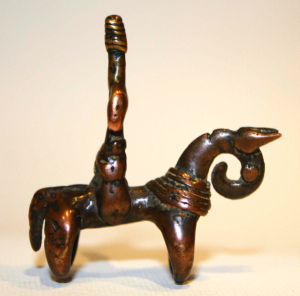
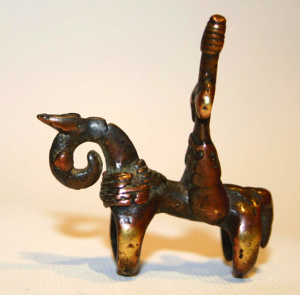
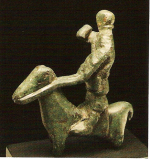
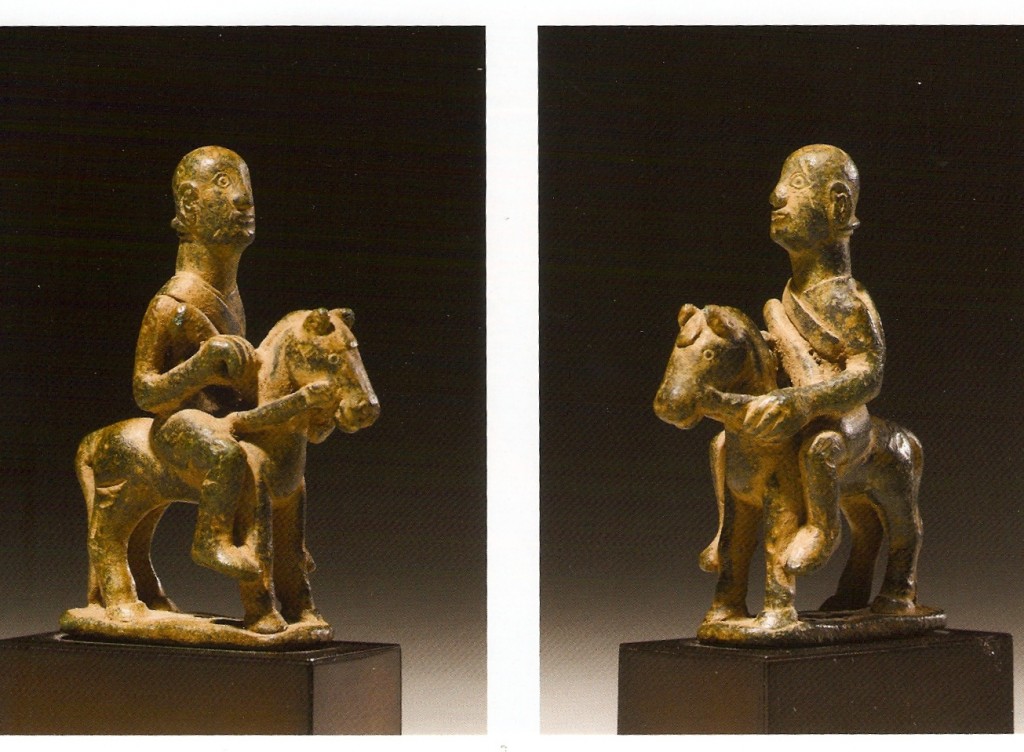
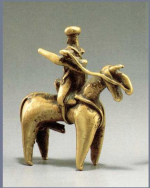
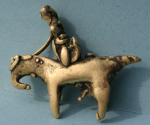
The Secret Of The Putchu Guinadji
by: Soul of Africa Museum
by Henning Christoph
editor Karen Barrett-Wilt
13-1-2014
I just got the precious message here above from a friend I don’t yet know, Pierre Boonefaes and whom I thank with all my heart.
I rushed to read the texy, whose link is :
http://www.kunstpedia.com/articles/the-secret-of-the-putchu-guinadji.html
Thanks Pierre and thanks Christoph for your very interesting text, for the photos and for the film I hope to see some day. Thanks mainly for your warning when you write : “The old “marabou” Bakura showed us some Putchu Guinadji and warned us not to touch them, because the madness of the former owners could pass on to us. He said that he had to rub each Putchu Guinadji with the Gwouabi plant to make them harmless.”.
Imagine Christoph that since many years I go out everyday bringing one of my Putchu Guinadji with me and I keep cuddling and fondling it for hours. Now, since I don’t have rubbed any of my Putchu Guinadji with Gwouabi plant beforehand, you can imagine how crazy must I be right now. Hopeless I am and very happy to be so crazy about our “crazy horses”. Franco
I heartily suggest to anyone interested in Putchu Guinadji not to miss this important text :
The Secret of the Putchu Guinadji
http://kunstpedia.com/articles/the-secret-of-the-putchu-guinadji.html
Henning Christoph really did add many interesting informations to the invaluable work of research on the field, study and writing done by Pierluigi Peroni.
To me Christoph gave a very precious warning, so important that I obviusly will not follow it. Too late.
Here is what I did write to Christoph to thank him :
Thanks Christoph. Thanks for your very interesting text, for the photos and for the film I hope to see some day. Thanks mainly for your warning when you write : “The old Kotoko marabout, called Bakoura, warned us not to touch the Putchu Guinadji, because the madness of the former owners could pass on to us.
He said that he had to rub each Putchu Guinadji with the Gwouabi plant to make them harmless”.
Imagine, Christoph, that since many years I go out everyday bringing one of my Putchu Guinadji with me
and I keep cuddling and fondling it for hours. Not having rubbed any of my Putchu Guinadji with Gwoubi plant beforehand,
you can imagine how crazy must I be right now.
Hopeless I am and very happy to be so crazy about our “crazy horses”.
Franco